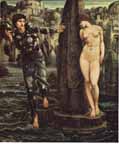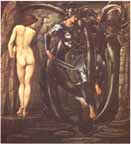Sir Edward Burne-Jones' Perseus cycle depicts the Greek myth of heroic Perseus. In two of the paintings, The Rock of Doom and The Doom Fulfilled, Burne-Jones offers the opportunity to analyze both his paintings and the myth through gender and voyeurism. In The Rock of Doom an armor-clad Perseus approaches a nude Andromeda chained to a phallic rock. He looks at her from the corner of his eye, as if stealing a peek at her. Andromeda, looking rather dejected, half-gazes at her rescuer. In Perseus she has the promise of salvation, yet her body language and facial expression betray no signs of hope or joy in this salvation. The Doom Fulfilled is almost a mirror opposite of The Rock of Doom, as Burne-Jones switches the positions of the figures. Andromeda stands on the left, her sinuous back to the viewer. Yet this time she is the one gazing over her shoulder at Perseus fighting the sea monster. Again, Perseus is fully clad in his armor and Andromeda is completely nude.
Burne-Jones' depiction of Andromeda is a study of beauty in the female form. She stands in contrapposto, with a body less human than purely sculptural. Burne-Jones gives her no purpose in the action, not even terror at her possible fate. He assigns her only a passive role of watching and being watched. And these meaningfully directed gazes between the figures invite the viewer to watch, to become a voyeur in this highly gendered myth of rescue.
Questions
Is the figure of Andromeda an instance of beauty for beauty's sake? Is she intended as a voyeuristic subject?
Why is Burne-Jones' Andromeda passive?
Compare The Rock of Doom and specifically The Doom Fulfilled to The Wheel of Fortune. Note in particular gender, clothed and unclothed figures, circularity of the sea monster and the wheel, and directed gazes.
Burne-Jones' Andromeda bears a striking resemblance to his depiction of Pygmalion's statue. What do they have in common in terms of both artistic depiction and ideological purpose?
Last modified 22 October 2006

